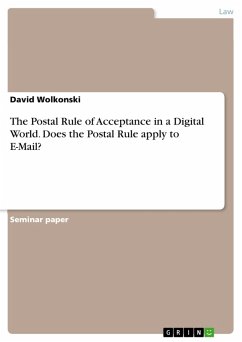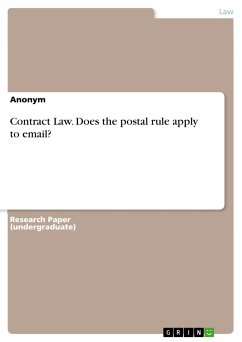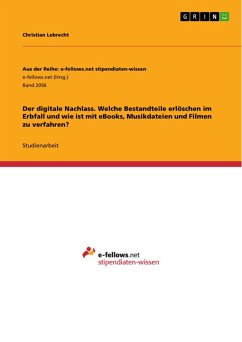Seminar paper from the year 2015 in the subject Law - Media, Multimedia Law, Copyright, grade: 1,0, University of Applied Sciences Osnabrück, course: Contract Law, language: English, abstract: This paper seeks to answer the question, if, and if so, how, the postal rule can be applied to modern technologies, the e-mail in particular. Since a contract is an important part of every day life and has an essential role in economical transactions, this is a question that has to be discussed. The two principal elements of a contract, offer and acceptance, have to be properly communicated. The way people communicate with each other has drastically changed over the last century, but some principles and theories of the English law system that are in use are centuries old. One such principle is the postal rule of acceptance. Over the course of years since the rule was introduced in the early 19th century, technology and ways of communication have change. Nowadays offer and acceptance are communicated more and more electronically besides the traditional way of written letters. Therefore, complications have arisen in applying the postal rule. One such complication is how the postal rule can be, and if it should be, applied to the forming of contracts via e-mail. The courts have not yet decided if this is the case. Modern technologies like the e-mail are not the first to question if the postal rule applies to them. Over the last 200 years different ways of communication were developed, changing the speed and efficiency of exchanging information. From the Telegraph in 1837 to the Telephone in 1876, the Telex in 1933 to the Fax in 1963, the jurisdiction had to decide if the postal rule has any relevance to these new technologies and how an acceptance will be treated if it is communicated with these methods. By analysing the decisions courts made regarding these technologies, there could be a reference how the e-mail could and should be treated. First, it is to be understood what the postal rule of acceptance is and why it was introduced, and what impact recent developments could have. After analysing the history, reasons and problems that the postal rule brought in context of different ways of communication and especially the e-mail, a clearer picture of the appliance of the postal rule should be possible. In the 19th century the postal rule provided a solution for a then real problem, transmitting acceptance by post was connected to some uncertainties and risks and still is to some degree. Today, many of these risks are minimized and new technologies offer faster and more reliable ways of communication.
Dieser Download kann aus rechtlichen Gründen nur mit Rechnungsadresse in A, B, BG, CY, CZ, D, DK, EW, E, FIN, F, GR, HR, H, IRL, I, LT, L, LR, M, NL, PL, P, R, S, SLO, SK ausgeliefert werden.









